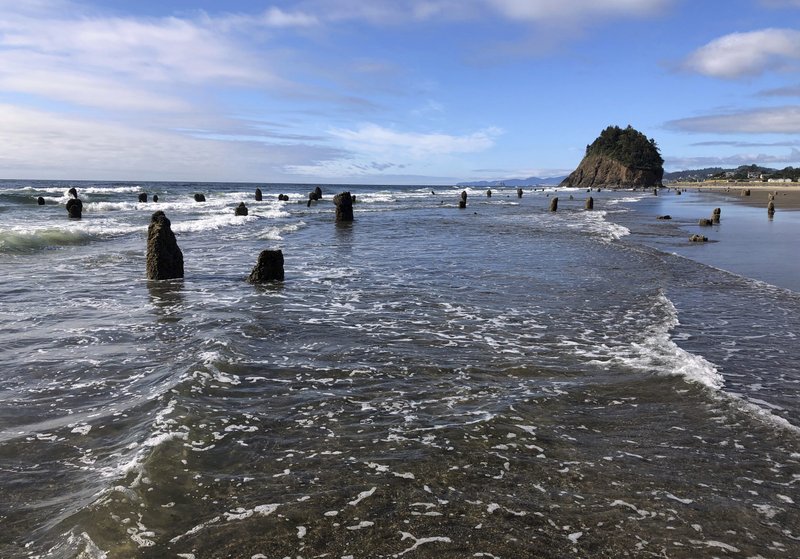Experts say it’s only a matter of time before the Cascadia causes a massive earthquake that generates a tsunami as much as seven stories tall and destroys parts of Oregon Coast.
But the Oregon’s Legislature repealed a ban on construction of new “critical facilities” in tsunami inundation zones, allowing fire stations, police stations and schools to be built in the potential path of a tsunami.

While we know the Cascadia earthquake is overdue and will be one of the most devastating natural disaster to hit northern America, now the Orgeon legislature has repealed a ban on construction of buildings in the tsunami prone areas along the Oragon coast. A pretty bad idea, I would say!
Passage of the bill in June was little noticed during one of the most tumultuous legislative sessions in Oregon history. But it has since been roundly criticized — including by Gov. Kate Brown, who told journalists the bill’s passage was one of her disappointments, even though she signed the measure and previously said it benefited economic development.
Chris Goldfinger, an Oregon State University professor and an earthquake geologist, says putting the $60 million oceanography building in the path of a tsunami is “beyond ironic,” and allowing even more construction threatens lives in favor of development.
“It’s foolhardy. In every other country in the world, best practice for tsunamis is avoidance, not building in a tsunami zone,” Goldfinger said at a symposium for journalists in Newport that included a tour of the construction project.
Proponents of the university facility point out that the building will withstand strong earthquakes and be higher than the biggest tsunami. It will feature a rooftop evacuation site that can accommodate more than 900 people, accessed via an exterior ramp.
Two days of supplies, including water, food and first aid, will be kept on the roof, said Cinamon Moffett, research facility coordinator for the marine center. Once the water subsides, survivors would be evacuated to a community college on a nearby hill, she said.
An earthquake in the Cascadia subduction zone, which extends in the ocean off Northern California to Canada’s Vancouver Island, has a 37 percent probability of happening off Oregon in the next 50 years, with a slightly lower chance of one striking near Washington state, Goldfinger said. Cascadia earthquakes have an average magnitude of around 9, making them among the world’s biggest.
Evidence of a Cascadia earthquake’s awesome destructive power is visible 30 miles (50 kilometers) up the coast from Newport.
There, a “ghost forest” of Sitka spruces juts up from a beach in the tiny town of Neskowin. An earthquake 2,000 years ago likely caused the ground beneath the trees to plunge, and tsunami debris buried them. The remnants were partially uncovered by storms in 1997. Today, the barnacle-encrusted trees stand like sentinels, facing the Pacific Ocean with vacation homes and a motel nearby.
The last time the ocean reared up from a Cascadia earthquake was in 1700. The estimated magnitude 9 quake sent a tsunami across the Pacific into the coast of Japan, where it flooded farm fields, damaged fishermen’s shacks and ascended a castle moat. In the Pacific Northwest and Canada, the impact was far worse, and is described in the folklore of indigenous peoples. One tale describes a struggle between a thunderbird and a whale that caused the earth to shake and the ocean to wash away people and homes.
Oregon became a leader in tsunami preparedness when the Legislature, in 1995, banned construction of certain public facilities in inundation zones.
Vancouver Island in Canada’s British Columbia province was slammed by the 1700 tsunami. But no law prohibits construction of public buildings in tsunami zones there, according to Emergency Management BC. Washington state requires municipalities and counties to establish rules to limit development in areas that are frequently flooded or could be hit by tsunamis, landslides or other calamities.
California has no state-mandated development restrictions in tsunami zones, said Rick Wilson, senior engineering geologist with the California Geological Survey. But the state recently adopted new language in its building code requiring that certain types of buildings be constructed to withstand tsunami forces, Wilson said. Other states are moving to do the same, using standards from the American Society of Civil Engineers.
Japan, reacting to a 2011 earthquake and tsunami that left more than 18,000 dead or presumed dead, passed a law allowing towns to set tsunami warning zones and make evacuation and reconstruction plans. The government is spending 1 trillion yen ($9 billion) to build giant seawalls around the northern coastline. Moving to higher ground is not required, though some coastal communities have done so.
“Oregon has gone from sort of a leader in this to full reverse,” said Goldfinger, who was attending a seismology conference in Japan when the 2011 earthquake hit.
Oregon lawmakers overwhelmingly repealed the 1995 construction ban in June, as tensions in the Capitol ratcheted up over Republican opposition to a bill addressing global warming. Few people attended hearings at which lawmakers from coastal districts testified in favor of the repeal.
Democratic Rep. David Gomberg, one of its sponsors, told members of a House committee to imagine the impacts if the state banned new schools, parking garages and police and fire stations in their communities.
“What would be the consequence of that, to your ability to get insurance on your home, your ability to attract a new business into a neighborhood that’s not safe enough for fire departments, your ability to resell your home in a neighborhood not safe enough for police departments?” Gomberg asked.
He said the state geology department should “help us rather than to stop … our communities growing, thriving or continuing.”
Gomberg said his bill gives the department responsibility for advising where a new inundation line should be and how risks can be mitigated. He also said he will introduce legislation for Oregon to adopt the American Society of Civil Engineers’ tsunami and earthquake building standards.
Republican Sen. Brian Boquist, who was at the center of a Republican walkout over the global warming bill, was the only senator to vote against the repeal. Boquist said in an email that it allows public entities to build, knowing full well the buildings will not survive a tsunami.
It is too soon to tell if coastal cities will use the new leeway to build facilities in inundation zones. Some have been doing the opposite. The town of Seaside, 70 miles (110 kilometers) northwest of Portland, is moving schools out of the tsunami zone.
Newport Mayor Dean Sawyer said his city has no plans to build critical facilities in the inundation zone. But he praised the Marine Studies Building for its rooftop evacuation site, which can fit the population of an entire neighborhood of his fishing town.
“We consider it to be a unique solution,” he said.
While it is possible to design a building that can survive an earthquake and tsunami that doesn’t answer the question of why we should take the risk in the first place.
Read More:
- https://olis.leg.state.or.us/liz/2019R1/Downloads/MeasureDocument/HB3309/Enrolled
- https://apnews.com/c5e6c1f5b1ad4e42ad835eb2eb296ed0












Progressives have destroyed a once beautiful state, but hey, if there’s a ton of money to be made by building in tsunami zones, Oregon’s ultra liberal government will be more than happy to take their cut.
Public safety, don’t worry. The legislators in Salem, Oregon’s capital city, will be safe as Salem is anywhere from 80-119 miles from the coast (depending where one travels to on the coast).
The 6th seal, following the 4th seal war during which 1/4th the earth is killed, shall cause massive continental shift that could leave Oregon under water. The only effective preventative measure is repentance.
MAKING SENSE OF REVELATION, A VERSE BY VERSE LITHOPHANE.
Repentance solves nothing. The world’s religions have been using just this sort of power and control to retard human development for millennia. As to the subject as hand: the response should be equal to the threat. Building in flood or tsunami zones is foolhardy.
AFTER the HAMMON and BUNDY rancher afair in OREGON,its pretty obivous the STATE OF OREGON is ran by california IDIOTS…IF you think I’am kidding,ASK THOSE TWO BIT WHORES ,why theres NO APPLES growing anywhere in the state…right across the state line in washington apples growing everywhere,right across the state line in Idaho ,apples growing everywhere,BUT NONE IN OREGON,ask those morons why…then you’ll understand,BUT you won’t believe anyone is that stupid…the average IQ of oregon hasbeens running the government, is around 60 IQ…IF STUPID were airplanes,every drive way in oregon would be an international airport….LET them build on the coast….